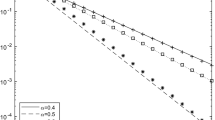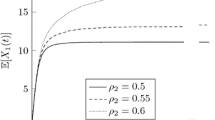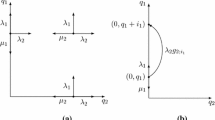Abstract
We consider a multi-class, multi-server queueing system with preemptive priorities. We distinguish two groups of priority classes that consist of multiple customer types, each having their own arrival and service rate. We assume Poisson arrival processes and exponentially distributed service times. We derive an exact method to estimate the steady state probabilities. Because we need iterations to calculate the steady state probabilities, the only error arises from choosing a finite number of matrix iterations. Based on these probabilities, we can derive approximations for a wide range of relevant performance characteristics, such as the moments of the number of customers of a certain type in the system en the expected postponement time for each customer class. We illustrate our method with some numerical examples. Numerical results show that in most cases we need only a moderate number of matrix iterations (∼20) to obtain an error less than 1% when estimating key performance characteristics.
Similar content being viewed by others
References
J.P. Buzen and A.B. Bondi, The response times of priority classes under preemptive resume in M/M/m queues, Operations Research 31(3) (1983) 456–465.
J.H.A. de Smit, A numerical solution for the multi-server queue with hyperexponential service time, Operations Research Letters 2(5) (1983) 217–224.
H.R. Gail, S.L. Hantler and B.A. Taylor, Analysis of a non-preemptive priority multiserver queue, Advances in Applied Probability 20(4) (1988) 852–879.
H.R. Gail, S.L. Hantler and B.A. Taylor, On preemptive Markovian queue with multiple servers and two priority classes, Mathematics of Operations Research 17(2) (1992) 365–391.
G. Hooghiemstra, M. Keane and S. van de Ree, Power series for stationary distributions of coupled processor models, SIAM Journal on Applied Mathematics 48(5) (1988) 1159–1166.
E.P.C. Kao and K.S. Narayanan, Computing steady state probabilities of a nonpreemptive priority queue, ORSA Journal on Computing 2 (1990) 211–218.
E.P.C. Kao and S.D. Wilson, Analysis of nonpreemptive priority queues with multiple servers and two priority classes, European Journal of Operational Research 118 (1999) 181–193.
O. Kella and U. Yechiali, Waiting times in the non-preemptive priority M/M/c queue, Communications in Statistics—Stochastic Models 1 (1985) 257–262.
C. Maglaras, Dynamic scheduling in multiclass queueing networks, Queueing Systems 31 (1999) 171–206.
D.R. Miller, Computation of steady-state probabilities for M/M/1 priority queues, Operations Research 29(5) (1981) 945–958.
I. Mitrani and P.J.B. King, Multiprocessor systems with preemptive priorities, Performance Evaluation 1 (1981) 118–125.
M.I. Reiman and L.M. Wein, Dynamic scheduling of a two-class queue with setups, Operations Research 46(4) (1998) 532–537.
C.C. Sherbrooke, Optimal Inventory Modelling of Systems: Multi-Echelon Techniques, (Wiley, New York 1992).
A. Sleptchenko, M.C. van der Heijden and A. van Harten, Effects of finite repair capacity in multi-echelon, multi-indenture service part supply systems, International Journal of Production Economics, 79 (2002) 109–230.
H.C. Tijms, Stochastic Models: An Algorithmic Approach, (John Willey and Sons, Chichester, 1994).
A. van Harten and A. Sleptchenko, On multi-class, multi-server queuing and spare part management, Queueing Systems 43(4) (2003) 307–328.
M.C. van der Heijden, A. Sleptchenko and A. van Harten, Approximations for Markovian multi-class queues with preemptive priorities, working paper, University of Twente, Faculty of Business, Public Administration and Technology (2002) (submitted for publication).
D. Wagner, of a finite-capacity multi-server model with non-preemptive priorities, European Journal of Operational Research 102 (1997) 227–241.
D. Wagner, Analysis of mean values of a multi-server model with non-preemptive priorities and non-renewal input, Communications in Statistics—Stochastic Models 13(1) (1997) 67–84.
D. Wagner, A finite-capacity multi-server multi-queueing model with non-renewal input, Annals of Operations Research 79 (1998) 63–82.
L.M. Wein, Dynamic scheduling of a multiclass make-to-stock queue, Operations Research 40(4) (1992) 724–735.
Author information
Authors and Affiliations
Corresponding author
Rights and permissions
About this article
Cite this article
Sleptchenko, A., Harten, A.v. & Heijden, M.v.d. An Exact Solution for the State Probabilities of the Multi-Class, Multi-Server Queue with Preemptive Priorities. Queueing Syst 50, 81–107 (2005). https://doi.org/10.1007/s11134-005-0359-y
Received:
Revised:
Issue Date:
DOI: https://doi.org/10.1007/s11134-005-0359-y




